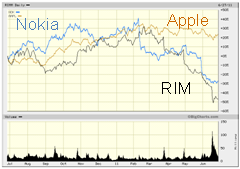
Smartphones: when will Huawei be No.1?
We were surprised to hear Huawei’s objective of becoming the world’s No.1 Smartphone maker at last year’s Mobile World Congress, and somewhat dubious whether it would achieve that goal. However, at this year’s show Huawei demonstrated impressive progress, and we consider it is no longer a question of if, but when it will achieve its goal. In this analysis we explore industry scenarios and their consequences. (March 2013, Executive Briefing Service).
Huawei Ascend Smartphone


